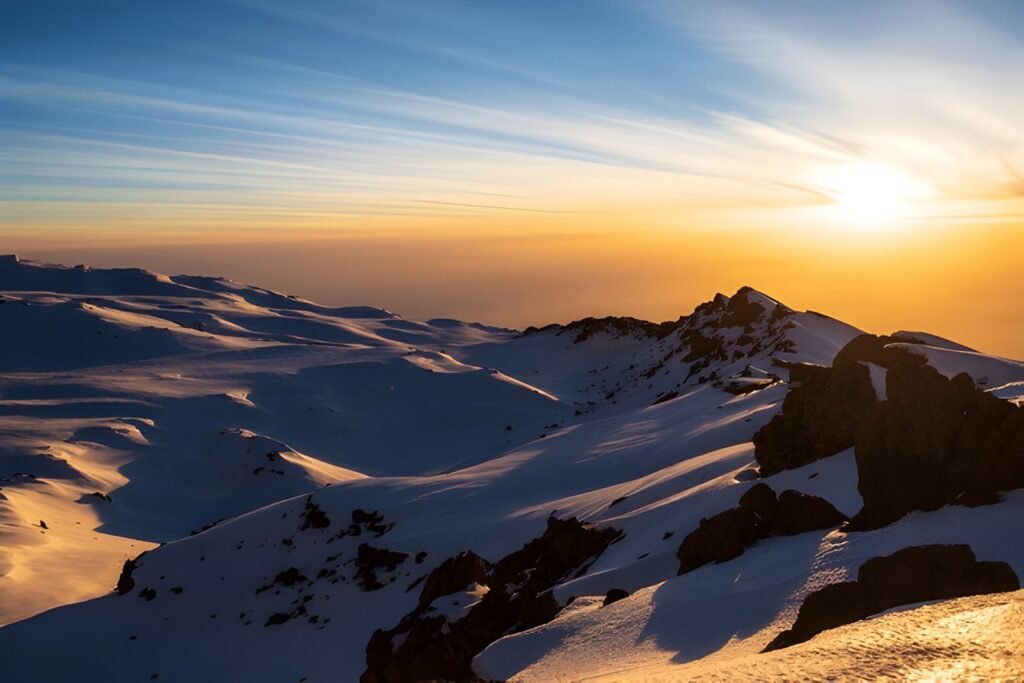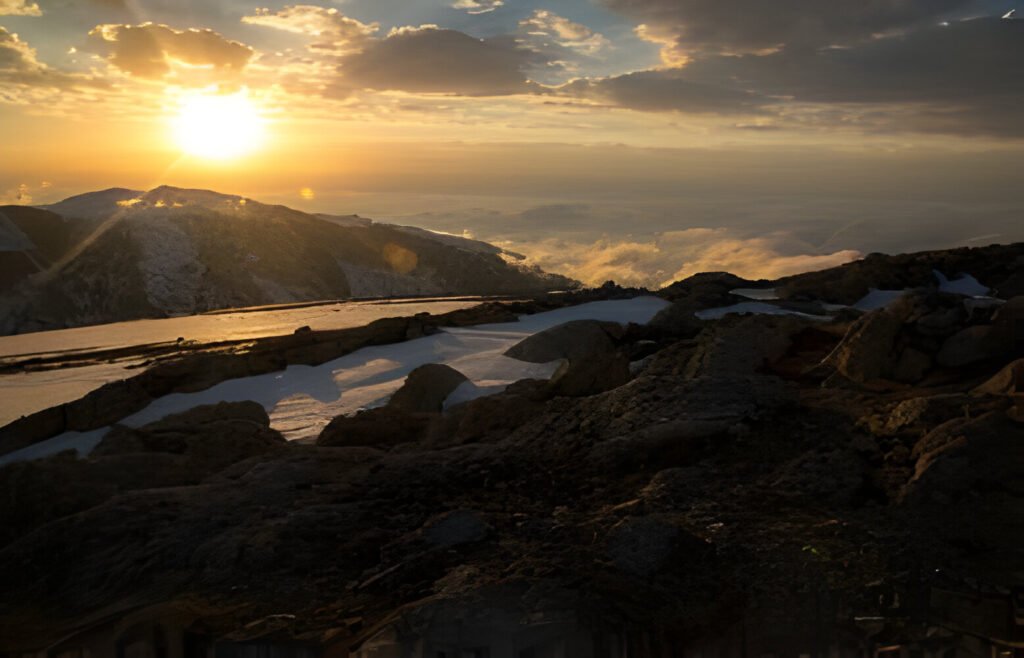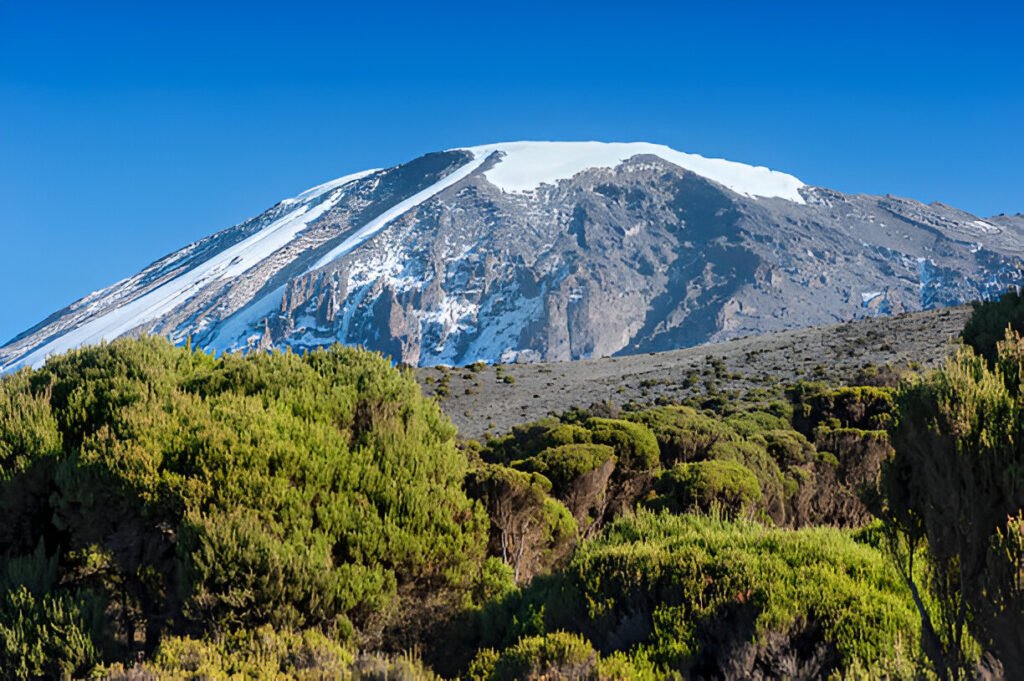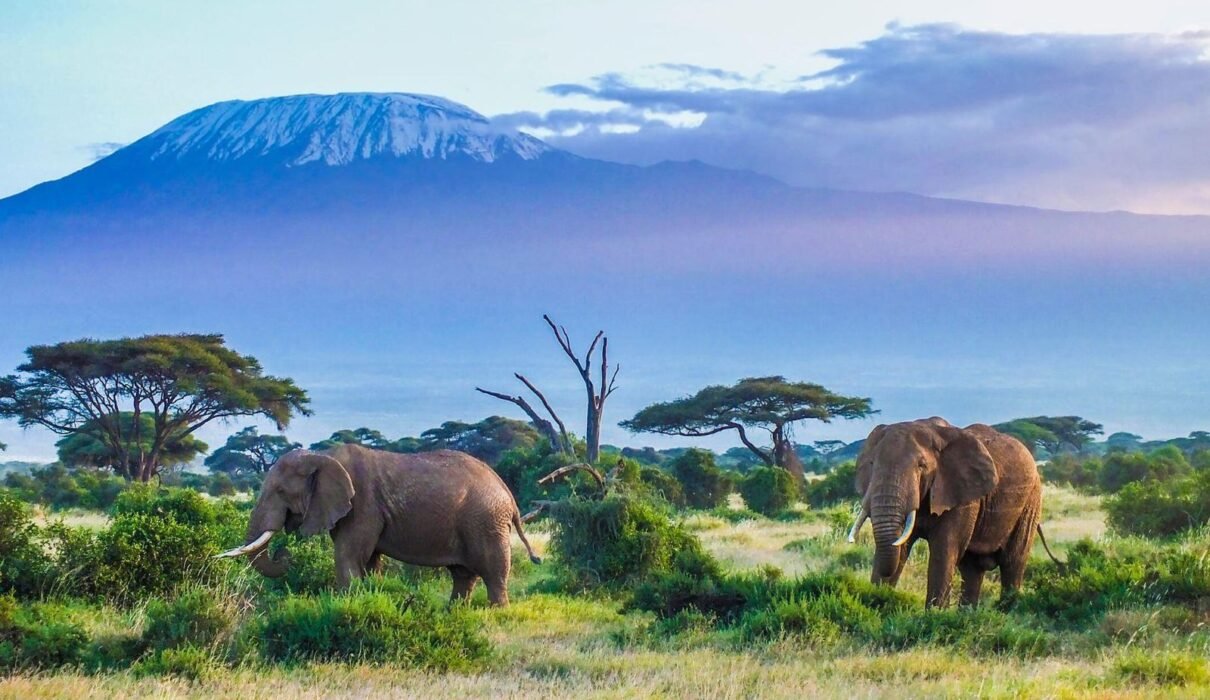Kilimanjaro National Park is a UNESCO World Heritage Site and home to the majestic Mount Kilimanjaro, Africa’s tallest mountain. This iconic destination draws thousands of adventurers and nature lovers every year. Whether you are planning to trek to the summit or explore the rich biodiversity of the surrounding areas, Kilimanjaro National Park offers an experience like no other. In this guide, we’ll explore the park’s top attractions, unique wildlife, and essential tips for planning your visit.
Start planning your Kilimanjaro adventure.

Kilimanjaro National Park : Mount Kilimanjaro: Africa’s Highest Peak
At 5,895 meters (19,341 feet), Mount Kilimanjaro stands as Africa’s highest peak and the world’s tallest free-standing mountain. Known for its snow-capped summit and breathtaking views, Kilimanjaro is a non-technical climb, making it accessible to a wide range of hikers. However, the altitude and diverse terrain make it a challenging yet rewarding experience.
- Summit Routes: Popular routes include the Machame, Marangu, and Lemosho trails, each offering unique views and varying degrees of difficulty.
- What to Expect: Climbing through Kilimanjaro’s five ecological zones, from tropical rainforest to arctic tundra, is an adventure in itself.
Learn about the best Kilimanjaro climbing routes.

Kilimanjaro National Park : Kilimanjaro’s Unique Ecological Zones
Kilimanjaro National Park is home to five distinct ecological zones, each offering a unique landscape and wildlife. From the lush forests at the base to the arctic conditions near the summit, Kilimanjaro’s terrain is incredibly diverse.
Ecological Zones:
- Rainforest Zone: The lower slopes are rich in biodiversity, home to colobus monkeys, birds, and elephants.
- Heather and Moorland Zone: As you ascend, the landscape becomes more barren, with wildflowers and giant heathers.
- Alpine Desert Zone: Harsh and dry, this zone is a stark contrast to the greenery below.
- Arctic Summit Zone: The summit is a cold, glacier-covered area with limited life, offering an unforgettable view of Africa.
Discover the biodiversity of Kilimanjaro’s ecological zones.
Kilimanjaro National Park : Wildlife in Kilimanjaro National Park
While most visitors come for the climb, Kilimanjaro National Park is also home to a variety of wildlife. The lower slopes of the park, especially the forested areas, are a haven for animals such as elephants, buffalo, leopards, and monkeys. Birdwatchers will also enjoy spotting over 180 species of birds, including the rare Abbott’s starling.
- Wildlife Encounters: Wildlife viewing is most common in the lower altitudes, particularly in the rainforest zone.
- Conservation Efforts: Kilimanjaro National Park is dedicated to protecting its unique ecosystems and wildlife, ensuring that future generations can enjoy the park’s natural beauty.
Learn more about Kilimanjaro’s wildlife.
Kilimanjaro National Park : Best Time to Visit Kilimanjaro National Park
The best time to visit Kilimanjaro National Park depends on whether you’re climbing or simply exploring the wildlife and scenery. The park experiences two main seasons: the dry season and the wet season. Most climbers prefer the dry season for better visibility and trail conditions.
Best Times to Visit:
- Dry Season (June to October): Ideal for climbing with clear skies and mild weather.
- Wet Season (March to May, November): The park’s lush greenery is at its peak, but trails can be slippery, making climbing more difficult.
Find out more about the best time to visit Kilimanjaro.
Kilimanjaro National Park : Top Attractions Beyond the Summit
While Kilimanjaro’s summit is the main attraction, Kilimanjaro National Park offers plenty to do even if you’re not planning to climb. From short hikes to cultural experiences with the local Chagga people, there’s something for everyone.
Must-See Attractions:
- Chala Crater Lake: A beautiful, tranquil crater lake on the mountain’s eastern slopes, perfect for a day trip.
- Waterfalls: The Materuni Waterfalls are a popular spot for a refreshing break, located just outside the park in a nearby village.
- Cultural Tours: Learn about the traditions of the Chagga people, who live on the slopes of Kilimanjaro and have a rich history intertwined with the mountain.
Discover more hidden gems around Kilimanjaro.
Kilimanjaro National Park : Preparing for Your Kilimanjaro Climb
Climbing Mount Kilimanjaro is a challenging but achievable feat with the right preparation. Both physical fitness and mental resilience are key to a successful climb. Here are a few tips to help you prepare:
- Training: Start training at least three months in advance. Focus on cardio exercises, such as hiking and running, and strength training for your legs.
- Acclimatization: Altitude sickness is one of the biggest challenges on Kilimanjaro. Choose a route that allows for proper acclimatization, and take your time during the ascent.
- Gear: Pack appropriate gear, including warm clothing, a waterproof jacket, and comfortable hiking boots.
Check out the ultimate Kilimanjaro packing list.
Kilimanjaro National Park : Safety Tips for Climbing Kilimanjaro
Safety should always be your top priority when climbing Kilimanjaro. The high altitude presents risks such as acute mountain sickness (AMS), but these can be mitigated with proper acclimatization and attention to your body’s signals.
Safety Tips:
- Climb Slowly: Take your time, ascend gradually, and listen to your guide’s advice.
- Stay Hydrated: Drink plenty of water to stay hydrated, especially at high altitudes.
- Choose a Reputable Guide: Always climb with a licensed guide who has experience on Kilimanjaro. They will help monitor your health and ensure your safety throughout the trek.
Learn more about Kilimanjaro safety tips.
Kilimanjaro National Park : Cultural Experiences Around Kilimanjaro
The local Chagga people have lived on the slopes of Kilimanjaro for generations, cultivating the fertile land and developing a rich culture. A visit to Kilimanjaro is not complete without exploring their traditions and hospitality.
What to Do:
- Coffee Tours: The Chagga are known for their coffee production. Join a tour to learn about traditional coffee farming methods.
- Village Visits: Explore the daily life of the Chagga people, including their traditional foods and crafts.
Discover more about cultural tours around Kilimanjaro.

Kilimanjaro National Park : Kilimanjaro’s Environmental Impact and Conservation Efforts
Kilimanjaro National Park is a protected area, and conservation is a priority to preserve its unique ecosystems. However, the increasing number of climbers has raised concerns about the environmental impact on the park’s fragile environments. Efforts are being made to minimize damage and ensure sustainable tourism.
Conservation Initiatives:
- Porter Welfare: Organizations work to ensure fair wages and working conditions for porters, who play a crucial role in supporting climbers.
- Waste Management: Eco-friendly trekking practices, such as pack-in, pack-out policies, are encouraged to reduce waste on the mountain.
Learn more about Kilimanjaro conservation efforts.
Kilimanjaro National Park : Conclusion
Whether you’re aiming to conquer the summit of Mount Kilimanjaro or simply explore the breathtaking natural beauty of Kilimanjaro National Park, this destination promises an unforgettable adventure. With proper preparation, respect for the local culture, and a focus on safety, your Kilimanjaro experience will be a rewarding and life-changing journey.
For personalized Kilimanjaro climbing packages and expert guidance, visit Kilimanjaro Climb Specialist or Eddy Tours & Safaris.

